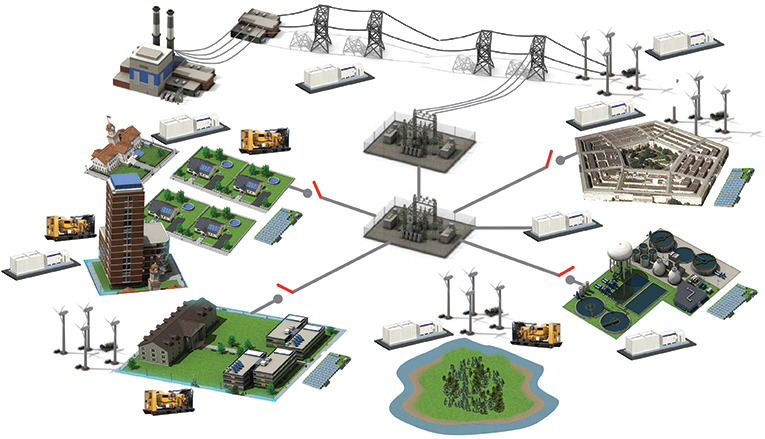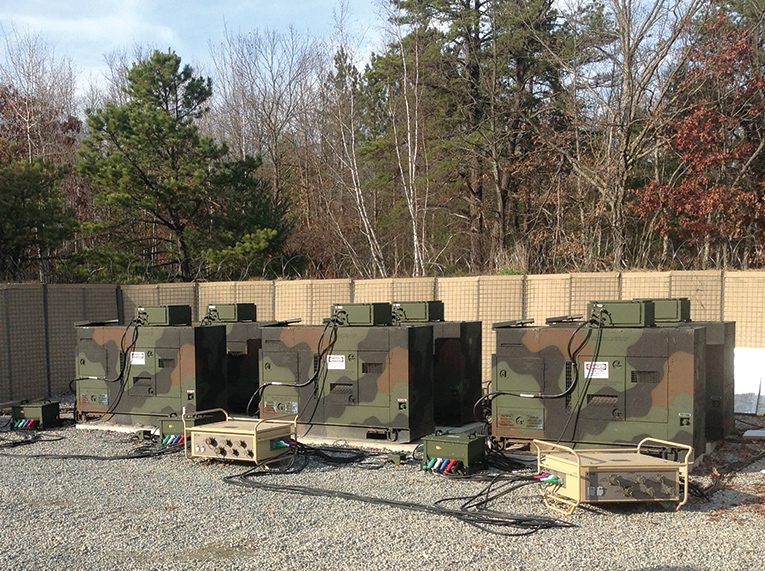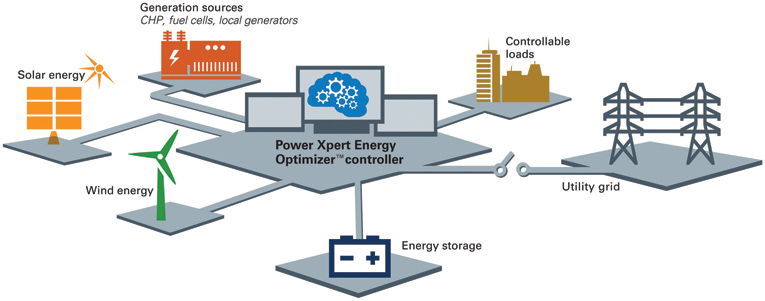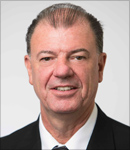With increased capacity of solar, wind, energy storage, combined heat and power (CHP) and other distributed energy resources (DER), there is an opportunity to optimize energy to support resiliency to critical areas. And, as technology and material costs for solar PV and energy storage have improved, it is now possible to generate reliable energy to improve grid resiliency at competitive market pricing levels.
Over the last decade, microgrids have become an increasingly compelling means to not only keep the power on, but to manage distributed energy resources and energy costs. According to GTM Research, the trends driving microgrid growth include:
- Energy resiliency requirements stemming from extreme weather/power outage events
- New business models for microgrid ownership that involve multiple stakeholders
- Technology innovations enabling strategic energy management
- Opportunity for microgrids that support commercial and industrial customers
In the Beginning: Department of Energy, Utility Project is the First of its Kind
In October of 2012, a 5 MW / 1.25 MWh energy storage system was completed as part of a broader U.S. De-partment of Energy Smart Grid Demonstration project in Salem, Oregon. This early energy storage system was integrated with an existing distribution feeder and utility-dispatched distributed generation to form a high-reliability zone. The system was an industry-first; using lithium-ion battery technology in a large, utility-scale application that could operate connected to the tradition¬al utility supply or as an island in voltage forming mode, allowing the generation on the feeder to connect to it.
When connected to the substation, through intelligent power management, the energy storage system can store or release energy depending on energy market conditions to optimize lower cost generation resources. The system can also prioritize renewable generation over fossil fuel plants, ensuring that the utility makes the best use of renewable energy that is already available.

Figure 1. Microgrids must be able to operate in parallel with the grid and as standalone electrical power systems that consist of multiple generating assets and often storage sources supplying loads, which can be powered independently of the primary utility transmission and distribution grid. (Image courtesy of Eaton.)
The integrated control system operates the energy storage system in a variety of modes by interfacing with inverters, power meters, battery management system and the utility’s upstream system controls. This closed-loop control system coordinates the operation of the inverters and balances states of charge among the 40 battery blocks. In the event of an upstream outage, the control system, combined with custom inverter programming, provides seamless support for loads— keeping the power on for commercial and residential customers served by the feeder. The system also allows the operator to request that the batteries be equalized in charge and enables the storage system to respond to real and reactive power commands from the utility, helping the utility test its smart-grid control algorithms.
The intelligent energy storage system along with the dispatchable generators create a high-reliability feeder that can detect faults and island the medium-voltage feeder — helping to improve service reliability. Inside of the high-reliability zone, a 2.5-mile smart feeder system provides reliable power for residential, commercial and light industrial customers. Additionally, the energy storage system has sufficient capacity to support the microgrid for several minutes, creating a backup power supply in case of an interruption.
Five years ago, the system was at the forefront of smart grid technologies — helping to build the intelligent distributed energy resources of today while continuing to deliver value to the utility’s customers. Today, the utility continues to add more features to the energy storage system.
Early Microgrids: Defense Initiatives Advance Technology and Demonstrate Capability
Energy resiliency and security is a critical concern for the Department of Defense (DoD), which needs to operate regardless of electric grid outages from cyber-attack, natural disaster, aging or lacking infrastructure, or equipment failure. The DoD is also responsible for most of the U.S. government fuel consumption and is one of the largest single consumers of energy in the world.
As such, it has a vested interest in ensuring energy resilience, reducing consumption and controlling costs and has pursued a variety of initiatives to reduce fuel needs and change the mix of resources that it uses.
The DoD recognized a shortage of demonstrated large-scale microgrids that would support its interests in energy security, reducing fuel cost, resupplying convoy casualties and increasing renewable energy capacity. In 2013, a full-scale demonstration project at Fort Sill in Oklahoma showed that such a system could work off of the grid and balance the use of solar, wind and natural gas backup power and store energy for later use.

Figure 2. Intelligent Mobile Power Distribution System. (Image courtesy of Eaton)
The project was part of the DoD’s effort to better reduce costs and increase reliability. The microgrid extended the smart grid to integrate renewable resources and optimize fuel mix, energy storage and system operations to reduce cost, carbon footprint and the system architecture—maximizing reliability and uptime.
The key innovation in this project involved adapting a conventional control system for monitoring and control of a microgrid with generators and inverters, instead of developing a system controller and monitoring from scratch. The project built on microgrid control technology to improve the level of maturity and demonstrate a full-scale DoD microgrid.
The Fort Sill microgrid provides valuable experience for seamless transitions between grid-connected and islanded operation and experience with a high concentration of dynamic and nonlinear loads. As microgrids are retrofitted into existing systems with a high penetration of dynamic loads, the Fort Sill microgrid demonstrated the ability to provide energy resilience by operating during grid outages, seamlessly transitioning between grid-connected and islanded operation, and integrated renewables and energy storage.
Microgrids on the Move
Military success and security in combat situations depend, in part, on safe and reliable access to fuel, which can come with a high price tag. Considering the price of fuel for forward operating bases, or the actual cost of buying, moving and protecting a gallon of petroleum, the costs of supplying battlefield generators with fuel has increased dramatically. This dependence and the threat it faces in forward operating bases led the U.S. Army to seek both energy alternatives and resource management strategies.
An intelligent mobile power distribution system (IMPDS) was developed in 2014 and is a reliable, energy-efficient system to help manage generator output. By transforming an independently operating system of generators into a demand managed microgrid, This intelligent mobile power distribution system provides power only where and when it is needed and can help limit the risks that troops face as they use, transport and store fuel.
The system supports resiliency by providing adequate power to meet current energy demands, instead of inefficiently engaging all the generators continuously, which can reduce energy waste. Further, the system also uses intelligent load management technology to prevent grid collapse in the event of a generator fault.
If one generator were to fail, the IMPDS prevents a stoppage of energy flow by shifting demand onto the supporting generators, thereby providing a constant, safe supply of power.
The U.S. Army’s military installation at Fort Devens, Massachusetts demonstrated that the demand-managed microgrid significantly outperformed the traditional approach that relies on multiple independent generators. This system reduced fuel consumption by more than 30 percent.
Enabling Technology
These and other successful early deployments helped advance and innovate on technology that is enabling new applications and driving value from microgrid systems. The control architecture is one of the most important elements of a microgrid system—it provides the brains behind the operation. In most current designs, the microgrid is tied to the upstream grid via a point of interconnection (POI) and is managed by local control of assets, which enables faster, semi-autonomous or autonomous control of the microgrid devices to better maintain operation within connected equipment limits.
Today, integrated, modular, distributed control architecture is becoming a reality. Using lessons learned from early projects, new technology that is pre-engineered, factory-designed and tested provides a replicable model that is designed for further customization to site-specific requirements. This approach can simplify microgrid projects that use a variety of renewable or distributed energy resources plus storage, making it easier to test the system and support forward compatibility as the system evolves. The easy configuration of the controller helps maximize the flexibility and scalability of the system while reducing engineering cost.
When looking for a controller, functionality should coordinate automated system sequencing in response to user commands, system status, limits or faults. Additional control functions could also include active control, data logging, alarm management and processing, as well as built-in security measures.
Industry Trends: The Move to a More Distributed Energy Model
It is more than a matter of the technology for microgrids and distributed energy resources being available. The costs to generate and store energy are decreasing, which is changing the nature of the utility grid from a centralized generation model to a distributed system of sources and loads. The electric system architecture is a system that allows consumers, especially consumers of large amounts of energy, to generate, store and manage energy usage. In effect, power generation is moving closer to the user due to the availability of microgrid system technology that can be leveraged with multiple types of renewable or distributed generation as well as the lower cost of energy storage.

Figure 3. Microgrid energy system (Image courtesy of Eaton.)
Solar Capacity Dramatically Increases, While Costs Decline
As the installed costs for solar PV projects have rapidly declined in recent years, more solar PV has been installed in the United States. The year 2016 was another record-breaker; the U.S. market added 14,762 MWdc of solar PV, just about doubling the capacity installed in 2015 and adding (on average) a new megawatt of solar PV capacity every 36 minutes. 2016 was also the first year that solar was the top source of new electric generating capacity brought online, making up 39 percent of added capacity.
As the number of installations increase, equipment prices have decreased; utility-scale system prices have fallen below $1 per watt for the first time according to GTM Research and the Solar Energy Industries Association (SEIA) reports. Today, enough solar energy is generated to power 8.7 million homes. And, analysts anticipate the industry will more than double installed solar capacity in the U.S. over the next five years, surpassing 100 GW.
Transformation: Combined Heat and Power (CHP) Systems
CHP is an efficient approach to generating electrical power — capturing heat that would be wasted to provide thermal energy that can be used for heating, cooling, hot water and industrial processes. CHP helps reduce energy costs, increase efficiency, reduce greenhouse gas emissions and support energy resiliency. And while this clean energy solution has been around for a century, it is underutilized and poised for growth according to a 2016 Department of Energy (DOE) report.
CHP can scale and be used in large industrial complexes, commercial building, institutions, municipal facilities and residential applications. DOE reports estimate that there is more than 240 GW of technical potential for CHP, largely in commercial facilities. The technical potential reflects an “estimation of market size constrained only by technological limits,” and it cites multiple trends driving growth, including lower costs and ability to support resiliency, utility interest and project replicability.
Energy Storage Predicted to Experience Explosive Growth
Nearly five years ago, a mere 0.34 GW of energy storage could be found globally. Fast-forward to today, and the market expects 6 GW of energy storage to be installed in 2017 alone.
Most of these deployments will be as utility-scale projects, while residential and non-residential projects are also showing significant growth. It is important to note that with the increased penetration of renewable energy resources, utilities are seeking to optimize these renewable assets to reduce grid impact and enhance stability—the sweet spot for energy storage.
Microgrid Drivers Today
The drivers for microgrid systems have evolved and the technology is being used by a broader mix of industries and applications. Installing a microgrid is no longer limited to science projects and forward operating military bases. Microgrids can now be easily applied to facilities that already have solar, storage or other on-site generation sources.
For example, a power management company’s Experience Center includes a full-scale operational microgrid, located in Warrendale, PA. The microgrid provides power continuity for utility grid interruptions and peak demand management, as well as a live platform for demonstrations and testing.The system, which was installed in 2017, takes advantage of solar PV and a natural gas generator, as well as recently added energy storage to power the lighting, HVAC and house loads for a large part of the facility. The system intelligently manages on-site energy resources and the utility supply to provide peak shaving, PV smoothing and shifting, demand management seamless islanding and reconnecting to grid power and grid-connected power factor.
As our electric grid becomes more complex, it is increas¬ingly important that it is smarter, more reliable, allows for bi- and multi-directional transmission, and is responsive to the fluctuating consumption habits of businesses, res¬idents and emerging community needs. This smarter grid will enable better control of energy costs, reductions in energy requirements, more effective support of sustain¬ability initiatives and improved power reliability.
Optimization Through the Lens of Experience and Technological Innovation
If microgrid projects continue to meet analyst estimates, we will be relying more on stored and renewable energy. As projects increase, it is important to consider supplier expertise, experience, business stability and success with prior projects.
Proven power engineering, substation automation and control experience are essential. Suppliers should also be able to provide rapid, dedicated, local support to help expedite projects, as well as on-the-ground expertise to address unforeseen challenges.
Solution providers should also be able to provide more than the right controller. Because every project carries unique circumstances, look for a supplier who understands the challenges of not only a microgrid energy system but also a power system and can plan for individual project’s needs today and in the future.
Every application for a community, business or military base is unique, and cus¬tomized solutions can help optimize, build and maintain an automated, secure and cost-effective renewable energy and storage project. A supplier’s past projects can be indicative of the depth of solutions experience. Often, those who offer an “end-to-end” solution, including design, procurement and installation, can help you achieve your renewable energy and storage goals in less time and at a lower installed cost.
 William Murch is the director of services for Eaton’s microgrid energy systems. Murch leads Eaton’s microgrid energy system solutions and has more than 30 years of experience in electrical systems. He has worked with customers across commercial, industrial and utility applications to solve complex power management challenges.
William Murch is the director of services for Eaton’s microgrid energy systems. Murch leads Eaton’s microgrid energy system solutions and has more than 30 years of experience in electrical systems. He has worked with customers across commercial, industrial and utility applications to solve complex power management challenges.
 Bruce G. Campbell currently leads Eaton’s microgrid control development team. His experience includes performing power quality investigations, electrical system analysis and design for utility, industrial and commercial power systems and leading various engineering teams. Campbell has also served as manager of Eaton’s High Power Test Laboratory, conducting high-current testing for product development and third-party certification.
Bruce G. Campbell currently leads Eaton’s microgrid control development team. His experience includes performing power quality investigations, electrical system analysis and design for utility, industrial and commercial power systems and leading various engineering teams. Campbell has also served as manager of Eaton’s High Power Test Laboratory, conducting high-current testing for product development and third-party certification.







